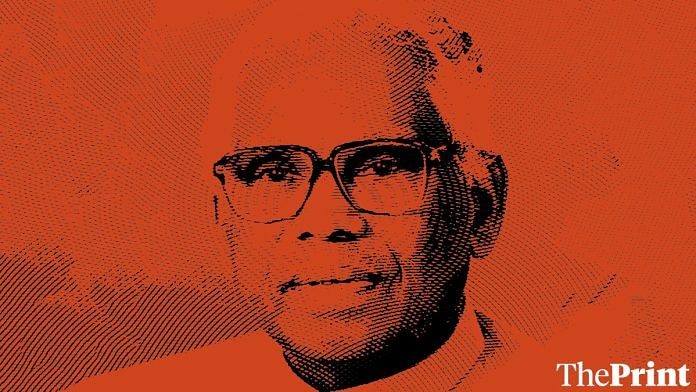New Delhi: When asked if being referred to as the India’s first Dalit President bothered him, K.R. Narayanan had said, “It used to disturb me because the Dalit aspect was not predominant in the mind of people who supported me during the process of the elections.”
Narayanan, the country’s 10th President, had an illustrious career adorned with many ‘firsts’. Apart from being the first Dalit President, he was also the first from his community to get a Master’s degree, the first journalist to serve as the President and the first President to vote in the 1998 general elections. Before him, India’s Presidents refrained from adult suffrage.
Narayanan had briefly worked with The Hindu and The Times of India in New Delhi between 1944 and 1945. He also taught at the Delhi School of Economics and was the vice-chancellor of Jawaharlal Nehru University in 1979.
When Narayanan was working as a journalist with TOI in 1945, he had interviewed Mahatma Gandhi, asking him questions on untouchability, social practices and their political significance.
It was Mahatma Gandhi’s wish that a Dalit should hold the country’s top post one day. Gandhi would have never thought that the young boy who had interviewed him would fulfil his wish after several decades.
On his death anniversary on 9 November, here is a look at the former President’s journey from a village in Kerala to the Rashtrapati Bhavan.
He won three general elections in Kerala
Kocheril Raman Narayanan was born at Uzhavoor village in the princely state of Travancore. According to official records, the date was 27 October 1920.
Narayanan was actually born on 4 February 1921, but his uncle, who had accompanied him on his first day in school, did not know the date, and randomly chose 27 October 1920 as his birth date and Narayanan let it remain official.
Narayanan’s family did not have enough resources to finance his education. He obtained his Bachelor’s and Master’s degrees from the University of Travancore (which is now University of Kerala) and managed to get the prestigious Tata scholarship, which led him to London School of Economics (LSE).
Narayanan studied economics in LSE with a specialisation in political science. Harold Laski, renowned economist and his teacher at the LSE, recommended Narayanan to former PM Jawaharlal Nehru for a job in the Indian Foreign Services — selection in which was only based on interviews at that time.
Following this, Narayanan joined the foreign services in 1949 and worked in the embassies of Rangoon (now Yangon), Tokyo, London, Canberra and Hanoi. He was also the ambassador of Thailand (1967-1969), Turkey (1973-1975) and China (1976). It was for the first time in 15 years that an Indian ambassador was sent to China.
Former diplomat A.K. Damodaran had said, “That he was personally chosen by Indira Gandhi in 1976 to head the mission in Beijing, which was closed for 15 years, speaks volumes about his credentials as a diplomat.”
Hailed as the best diplomat of the country by Nehru, Narayanan joined politics on Indira Gandhi’s request and went on to win three general elections in 1984, 1989 and 1991 from Kerala’s Palakkad on a Congress ticket and was a minister in the Rajiv Gandhi government.
In August 1992, Narayanan became the Vice-President of the country. Five years later, in 1997, he took office as the President after winning the election with 95 per cent of the votes.
Raising voice for rights of Dalits, tribals & women
Narayanan raised his voice for the rights of the Scheduled Caste, Scheduled Tribes during his Presidential term.
In his address to the nation during the Golden Jubilee celebrations of Republic Day in 2000, Narayanan expressed his concern over how social, economic and political justice still remain an unfulfilled dream for millions of Indians even 50 years after India became a republic.
Narayanan also said the status of women in the country was “the greatest national drawback”. He supported the Women’s Reservation Bill and said the major gains of democracy was the “ever-growing active participation of women in the political process, not just as voters but as elected representatives”.
He questioned BJP govt over Babri, 2002 riots
“So, my image of a President is of a working President, not an executive President, but a working President, and working within the four corners of the Constitution,” Narayanan had said in an interview. This was true as he kept questioning the then BJP-led government over several issues.
He expressed his displeasure over the government’s stance on some issues, including the Babri Masjid-Ram Temple dispute. Narayanan described the demolition of Babri Masjid as the greatest tragedy India faced after the assassination of Mahatma Gandhi. He also returned cabinet resolutions seeking the imposition of President’s Rule in Uttar Pradesh and Bihar in 1997 and 1998, respectively.
Narayanan had criticised the Atal Bihari Vajpayee government for not taking appropriate actions early enough to stop the communal riots in Gujarat in 2002. Calling the riots the “most difficult dilemma of his career”, he had later said he did suggest the government to deploy Army, but the government did not follow up with action. Narayanan also spoke against a revision of the Constitution proposed by the Vajpayee government in 2000.
Narayanan passed away in 2005 at the age of 85. He was suffering from pneumonia and also had a kidney failure. He is and will be remembered as the President, who never shied away from speaking his mind and didn’t hesitate to call a spade a spade.




“India’s first Dalit President” his caste group is under scanner and debated in the state by other caste groups whether to be considered”dalit’